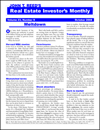John T. Reed's analysis of John Schaub’s Special Report
Buying and Building New Houses


(This article first appeared in Real Estate Investor's Monthly.)
I recommend this 38-page booklet on a rarely-written-about list of strategies. It covers buying model homes and leasing them back to the builders. A huge syndicator called EPIC did that and went spectacularly bankrupt (See the 5/86 and 8/92 issues), but the strategy can be employed profitably. The problem with syndicators was that they got paid for doing deals; not for doing good deals. As an individual investor, you have to do only deals that makes sense.
Buying new homes that builders are having trouble selling as another strategy. Unlike regular homeowners, builders will often sell below their cost, Schaub says. That’s because they are businessmen and are not emotionally attached to the home the way Joe Homeowner is. Schaub likens builders to sharks in that they need to keep moving to survive. A house that is hard to sell stops them from moving. I wrote about that in “Home builder left-overs” in the 4/92 issue.
Schaub covers buying now homes where workman and/or suppliers have not been paid by the original builder. That is analogous to buying property with too many liens on it. Fundamentally, the workmen and suppliers must be paid because they can easily place liens on the property.
Schaub covers building new homes on spec, a tactic he says should only be employed in hot markets. Such timing is easier said than done. More useful advice in the Report says you should be somewhat established before you play the new-home game. Then you can survive bad timing.
One tactic I never heard of is buying from recent buyers of new homes. It is very hard for a homeowner to resell a new home as long as the builder is still selling homes in that same subdivision. Builders typically offer special financing as well as a new, rather than used, home. Buyers of brand new homes get to make all sorts of fun decisions that have already been made in the resale home. But, nevertheless, some recent new home buyers have to sell. Schaub has bought some of these. They are typically upside down. That is, the loan balance exceeds the seller’s net sale proceeds. Schaub says he has been paid to take some of these houses.
A new-home technique that Schaub does not cover in this report is buying at distressed builder auctions. I wrote about that in the 9/91 issue.
The report is real world. For example, many people think new homes are maintenance free. Schaub points out the truth: they are only maintenance free after you install the landscaping, fences, and work out the bugs in the house. Prior to that time, they require more maintenance than an established old house.
I disagree with some of Schaub’s advice. He says he has never borrowed from an institutional lender to buy a property. He characterizes that as a “philosophical” rule of his. It sounds nutty to me.
Borrow from whomever offers you the best deal. In the vast majority of cases, that is an institutional lender. He prefers private loans. I advocate both. I discussed the advantages and disadvantages of each in my book How to Use Leverage to Maximize Your Real Estate Investment Return (now 3 volumes). One big disadvantage of private loans is they tend to be for much shorter terms than you should consider.
Schaub says to ban smoking and pets and put a clause in the lease saying the tenants forfeit their deposit if they do either. I like the ban, but courts do not like forfeits. They prefer actual damages. And it is a bad idea to tell a tenant who has not yet moved out that he has no chance of getting any security deposit back.


Schaub also advocates the use of lease options. I believe lease options are only rarely both ethical and useful.
Schaub’s Report is $29 and is available from 800-237-9222. Readers who are interested in this topic would also enjoy my book How to Buy Real Estate for at Least 20% Below Market Value. It has several chapters that cover some of the techniques that Schaub covers. JTR